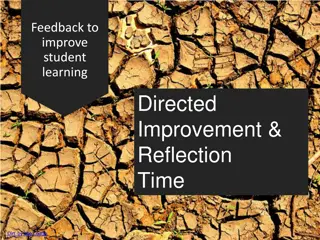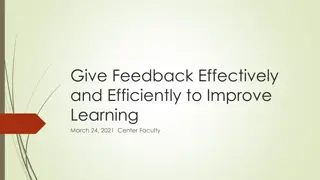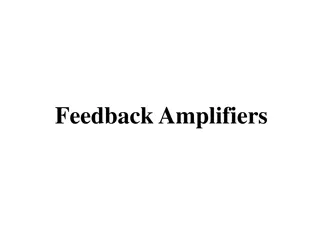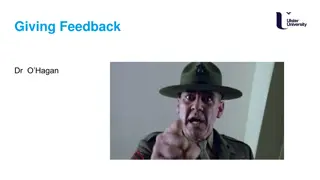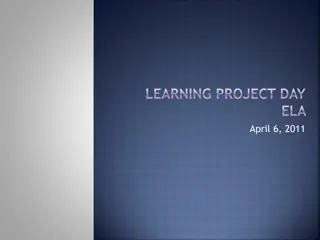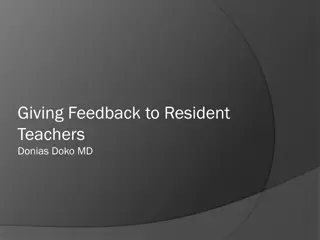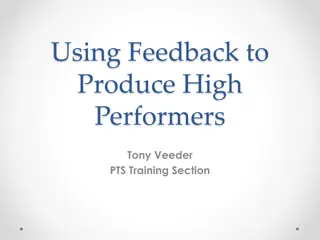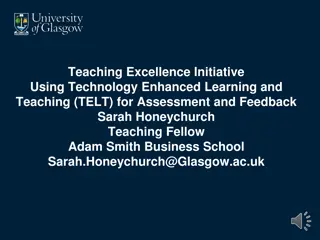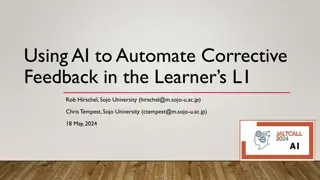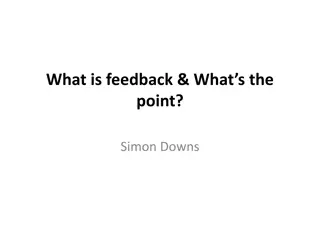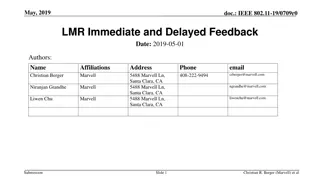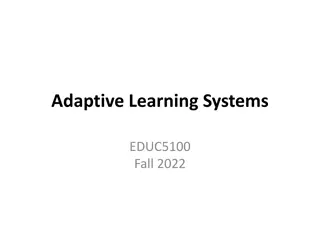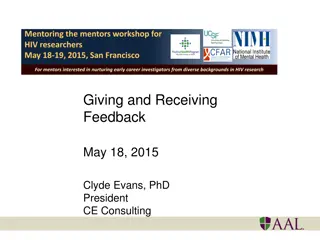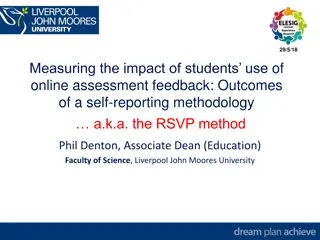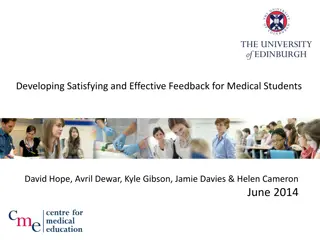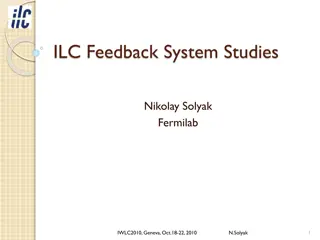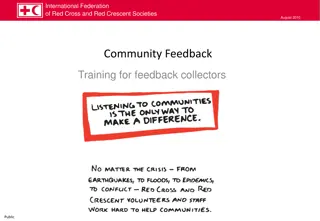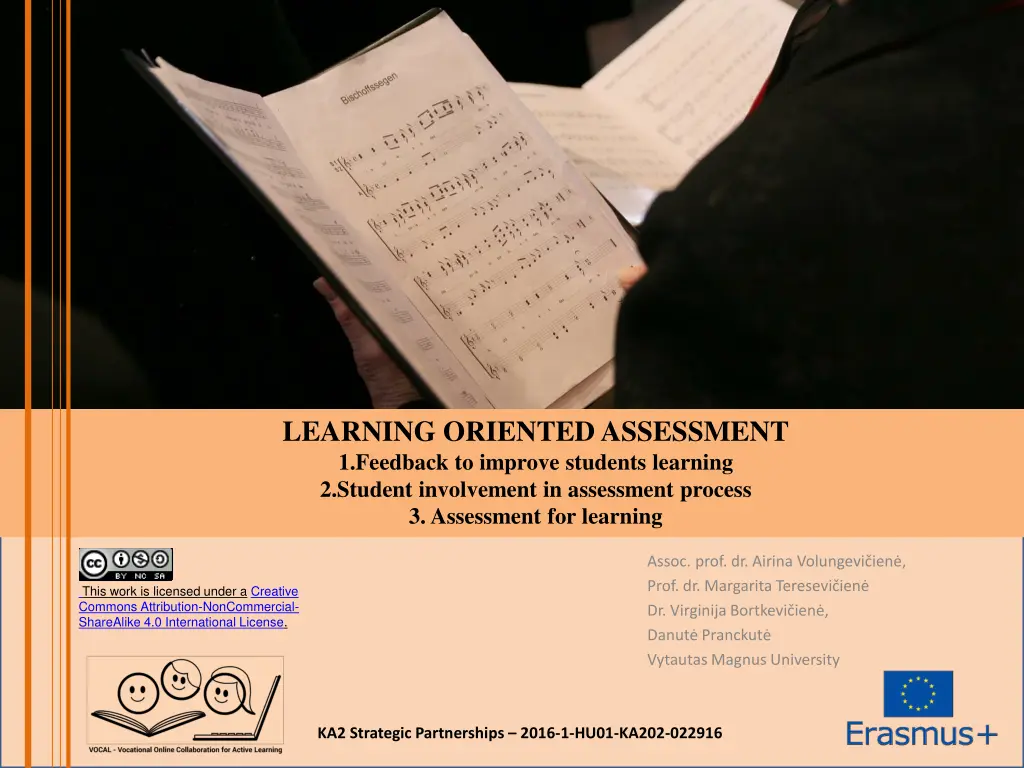
Enhancing Student Learning Through Feedback and Involvement in Assessment
Explore the importance of providing feedback to improve student learning and involving students in the assessment process for enhanced educational outcomes. Discover strategies to promote student engagement, self-assessment, peer assessment, and co-assessment in a learning-oriented approach.
Download Presentation

Please find below an Image/Link to download the presentation.
The content on the website is provided AS IS for your information and personal use only. It may not be sold, licensed, or shared on other websites without obtaining consent from the author. If you encounter any issues during the download, it is possible that the publisher has removed the file from their server.
You are allowed to download the files provided on this website for personal or commercial use, subject to the condition that they are used lawfully. All files are the property of their respective owners.
The content on the website is provided AS IS for your information and personal use only. It may not be sold, licensed, or shared on other websites without obtaining consent from the author.
E N D
Presentation Transcript
LEARNING ORIENTED ASSESSMENT 1.Feedback to improve students learning 2.Student involvement in assessment process 3. Assessment for learning reative Commons License Assoc. prof. dr. Airina Volungevi ien , Prof. dr. Margarita Teresevi ien Dr. Virginija Bortkevi ien , Danut Pranckut Vytautas Magnus University This work is licensed under a Creative Commons Attribution-NonCommercial- ShareAlike 4.0 International License. KA2 Strategic Partnerships 2016-1-HU01-KA202-022916
1.FEEDBACK TO IMPROVE STUDENTS LEARNING The best way to provide feedback is to compare assignment submitted in the virtual learning environment or another online environment against the criteria that are listed well in advance along with their weight. Research proved that feedback as a form of formative assessment can help to develop deep learning among students (Biggs, 1999). References: Biggs, J. (1999) Teaching for Quality Learning at University (Buckingham, Open University Press). KA2 Strategic Partnerships 2016-1-HU01-KA202-022916
FEEDBACK: WATCH THE VIDEO https://youtu.be/m-_ZyUSq3Lg References: KA2 Strategic Partnerships 2016-1-HU01-KA202-022916
FEEDBACK FOR IMPROVEMENT Comments on students work should act as guidance showing how the student can improve. You could develop this by asking students to write in the same way when peer assessing work. KA2 Strategic Partnerships 2016-1-HU01-KA202-022916
FEEDBACK FOR IMPROVEMENT Comments should make it clear how the student can improve. Plan activities and work with feedback in mind let the design assist the process. KA2 Strategic Partnerships 2016-1-HU01-KA202-022916
2. STUDENTS INVOLVEMENT IN ASSESSMENT PROCESS Learners may be involved in assessment through self- assessment, through peer assessment and through co- assessment. Self involvement of learners in making decisions about their own learning, particularly about their achievements and learning outcomes (Boud, Falchikov, 1989). - assessment may be realized through the References: Boud, D., & Falchikov, N. (1989). Quantitative studies of self- assessment in higher education: a critical analysis of findings. Higher Education KA2 Strategic Partnerships 2016-1-HU01-KA202-022916
STUDENTS INVOLVEMENT IN ASSESSMENT PROCESS Peer - assessment is the process whereby individuals evaluate their peers (Falchikov, 1995; Freeman, 1995). Evaluating the work of peers is a non- anonymous mode of assessment, therefore, the process is also involving learners into the decision or agreement at an early stage. References:Falchikov, N. (1995). Peer feedback marking: developing peer assessment. Innovations in Education and Training International. Freemen, M. (1995). Peer assessment by groups of group work Assessment and Evaluationin Higher Education KA2 Strategic Partnerships 2016-1-HU01-KA202-022916
STUDENT INVOLVEMENT IN ASSESSMENT PROCESS Co-assessment is a form of learner participation together with the teacher in the assessment process. This process provides an opportunity for learners to assess themselves while allowing the teachers to carry out the control over the final judgement. Self-, peer- and co-assessments should not be viewed as assessment methods. They only indicate that the student is involved as one of the assessors. References: Based on: https://www.reading.ac.uk/engageinassessment/using-technology/eia-managing-assessment-with-technology.aspx KA2 Strategic Partnerships 2016-1-HU01-KA202-022916
ASSESSMENT AS LEARNING DESIGN There are multiple taxonomies of assessment: 1. Inquiry based learning; For more information: https://teachingtools.ophea.net/supplements/inquiry-based-learning/assessment-inquiry-based- learning 2. Flipped classroom learning assessment For more information: https://www.edutopia.org/blog/five-steps-formative-assessment-jon-bergmann 3. Interactive and connected learning For more information: https://www.brookings.edu/wp-content/uploads/2016/06/1006_personalize_learning_west.pdf KA2 Strategic Partnerships 2016-1-HU01-KA202-022916
ASSESSMENT AS LEARNING DESIGN There are multiple taxonomies of assessment: 4. Distributed cognition For more information: http://mcs.open.ac.uk/yr258/dist_cog/ 5. Student generated content For more information: https://www.ncbi.nlm.nih.gov/pmc/articles/PMC3142969/ 6. Personalized learning For more information: http://www.personalizelearning.com/p/home.html (by Barbara Bray and Kathleen McClaskey in their blog) https://youtu.be/vPVrLBeXGko KA2 Strategic Partnerships 2016-1-HU01-KA202-022916
ASSESSMENT OF LEARNING Assessment OF learning (Individualization) refers to strategies designed to confirm what learners know, demonstrate whether or not they have met curriculum outcomes or the goals of their individualized programs, or to certify proficiency and make decisions about learners future programs or placements. KA2 Strategic Partnerships 2016-1-HU01-KA202-022916
ASSESSMENTAS LEARNING Assessment AS learning (Personalization) is based in research about how learning happens, and is characterized by learners reflecting on their own learning and making adjustments so that they achieve deeper understanding. KA2 Strategic Partnerships 2016-1-HU01-KA202-022916
ASSESSMENTAS AND OF LEARNING: WATCH THE VIDEO https://youtu.be/vPVrLBeXGko KA2 Strategic Partnerships 2016-1-HU01-KA202-022916
ASSESSMENT FOR LEARNING Assessment for Learning is the process of seeking and interpreting evidence for use by learners and their teachers to decide where the learners are in their learning, where they need to go and how best to get there (Broadfoot et al., 2002 pp. 2-3) References:Broadfoot, P. M., Daugherty, R., Gardner, J., Harlen, W., James, M., & Stobart, G. (2002). Assessment for learning: 10 principles. Cambridge, UK: University of Cambridge School of Education. KA2 Strategic Partnerships 2016-1-HU01-KA202-022916
ASSESSMENT FOR LEARNING Assessment for learning is any assessment for which the first priority in its design and practice is to serve the purpose of promoting students learning. It thus differs from assessment designed primarily to serve the purposes of accountability, or of ranking, or of certifying competence. An assessment activity can help learning if it provides information that teachers and their students can use as feedback in assessing themselves and one another and in modifying the teaching and learning activities in which they are engaged. Such assessment becomes formative assessment when the evidence is actually used to adapt the teaching work to meet learning needs. (Black et al., 2004 p. 10) References: Black, P., Harrison, C., Lee, C., Marshall, B. and Wiliam, D. (2004) Assessment for Learning. Putting it into Practice. Maidenhead: Open University Press. KA2 Strategic Partnerships 2016-1-HU01-KA202-022916
ASSESSMENT FOR LEARNING Assessment for learning means to: Explain the learning goals and feedback; Check the learner's understanding of learning goals; Brief learners about what they have to do and what they have to do; Introduce the assessment criteria to learners; Provide learners to apply the assessment criteria to work examples, possibly by a previous cohorts, in order to demonstrate the required standards and the application of the assessment criteria; References: http://dera.ioe.ac.uk/7800/1/AssessmentforLearning.pdf KA2 Strategic Partnerships 2016-1-HU01-KA202-022916
ASSESSMENT FOR LEARNING Assessment for learning means to: Provide learners to apply the assessment criteria to work examples, possibly by a previous cohorts, in order to demonstrate the required standards and the application of the assessment criteria; Provide the necessary instructions and support to learners individually and provide oral feedback; Provide peer assessment capabilities. Provide self-assessment opportunities; Conduct teacher-led assessment of learners work; Provide written feedback to learners; To enable learners to undertake corrective action and / or consolidation activities. References: http://dera.ioe.ac.uk/7800/1/AssessmentforLearning.pdf KA2 Strategic Partnerships 2016-1-HU01-KA202-022916
How to use and to plan Assessment for Learning in classroom practice? How to plan for learning? What teachers need to do? Decide what you intend to learn in a particular session; Define the learning goal; To transfer the learning goals to learners; Collect questions and design tasks to test learner's understanding of the learning goals; References: http://dera.ioe.ac.uk/7800/1/AssessmentforLearning.pdf KA2 Strategic Partnerships 2016-1-HU01-KA202-022916
How to use and to plan Assessment for Learning in classroom practice? How to plan for learning? What teachers need to do? Explain to the learners the criteria that will be used to assess their work; Decide how feedback will be provided; Determine how learners will actively participate in the assessment process; Plan opportunities for learners to use feedback from the assessment decision on further progress. Based on: http://dera.ioe.ac.uk/7800/1/AssessmentforLearning.pdf KA2 Strategic Partnerships 2016-1-HU01-KA202-022916
ASSESSMENT TASKS AS LEARNING TASKS Assessment tasks are not learning and teaching units, but they generally indicate what kind of learning should occur before students perform the assigned assessment. Based on: https://emedia.rmit.edu.au/learninglab/content/assessment-tasks KA2 Strategic Partnerships 2016-1-HU01-KA202-022916
ASSESSMENT TASKS AS LEARNING TASKS Each assessment task has the following information: Its relevance to country or territory curriculum Pre-requisite training is required A series of scaffolding activities are used to identify the context in which the task can be performed Resources to help students and teachers to complete their assignment Based on: https://emedia.rmit.edu.au/learninglab/content/assessment-tasks KA2 Strategic Partnerships 2016-1-HU01-KA202-022916
ASSESSMENT TASKS AS LEARNING TASKS Teachers' and Student Assessment Bases Examples of work annotations Offered further training and learning activities. Based on: https://emedia.rmit.edu.au/learninglab/content/assessment-tasks KA2 Strategic Partnerships 2016-1-HU01-KA202-022916
References Biggs, J. (1999) Teaching for Quality Learning at University (Buckingham, Open University Press Black, P., Harrison, C., Lee, C., Marshall, B. and Wiliam, D. (2004) Assessment for Learning. Putting it into Practice. Maidenhead: Open University Press. Boud, D., & Falchikov, N. (1989). Quantitative studies of self-assessment in higher education: a critical analysis of findings. Higher Education Broadfoot, P. M., Daugherty, R., Gardner, J., Harlen, W., James, M., & Stobart, G. (2002). Assessment for learning: 10 principles. Cambridge, UK: University of Cambridge School of Education. Freemen, M. (1995). Peer assessment by groups of group work Assessment and Evaluation in Higher Education Falchikov, N. (1995). Peer feedback marking: developing peer assessment. Innovations in Education and Training International. KA2 Strategic Partnerships 2016-1-HU01-KA202-022916
References https://www.reading.ac.uk/engageinassessment/using-technology/eia-managing- assessment-with-technology.aspx https://teachingtools.ophea.net/supplements/inquiry-based-learning/assessment- inquiry-based-learning https://www.edutopia.org/blog/five-steps-formative-assessment-jon-bergmann https://www.brookings.edu/wp- content/uploads/2016/06/1006_personalize_learning_west.pdf http://mcs.open.ac.uk/yr258/dist_cog/ https://www.ncbi.nlm.nih.gov/pmc/articles/PMC3142969 http://www.personalizelearning.com/p/home.html https://www.youtube.com/watch?v=vPVrLBeXGko http://dera.ioe.ac.uk/7800/1/AssessmentforLearning.pdf https://emedia.rmit.edu.au/learninglab/content/assessment-tasks KA2 Strategic Partnerships 2016-1-HU01-KA202-022916

